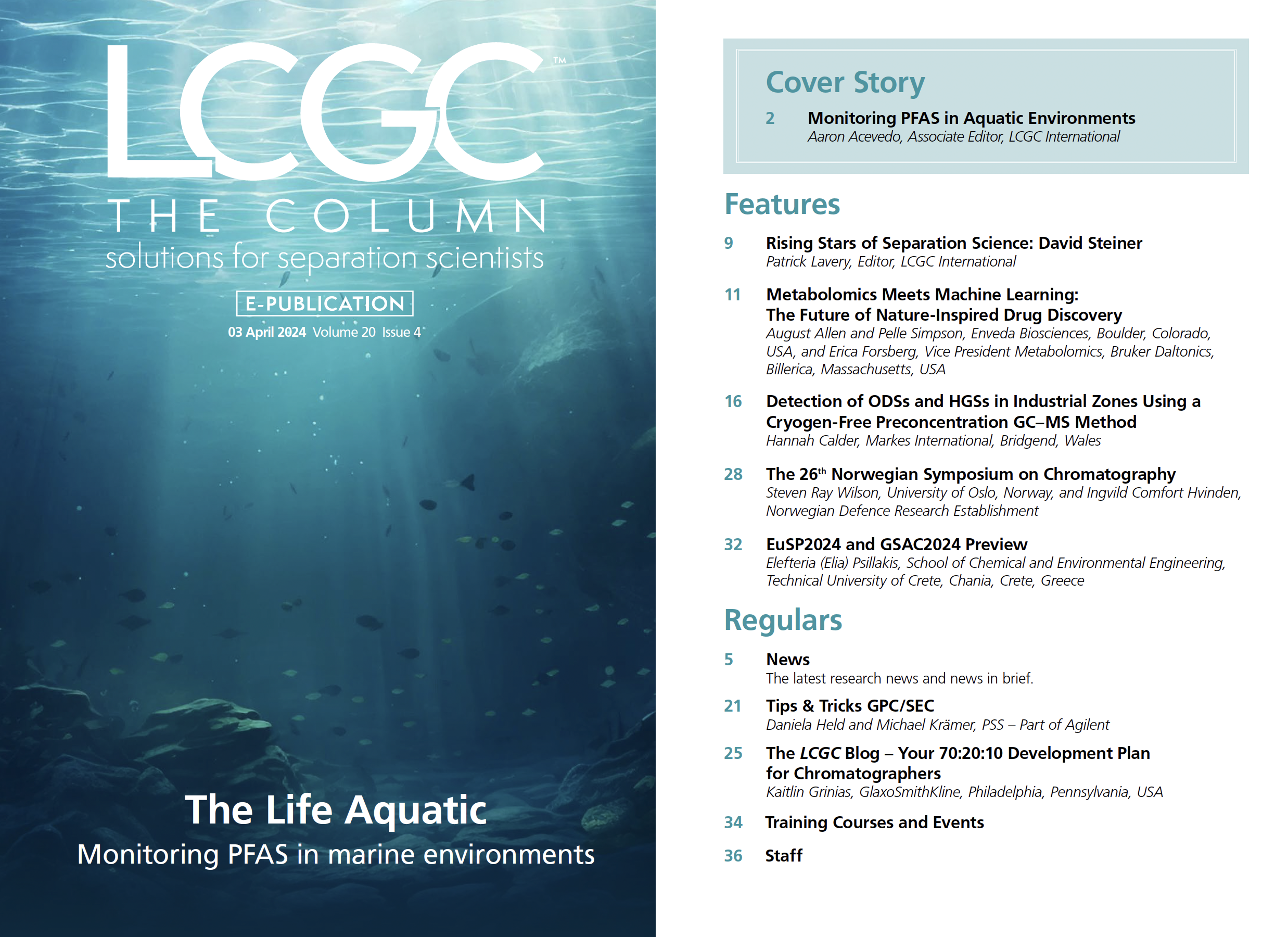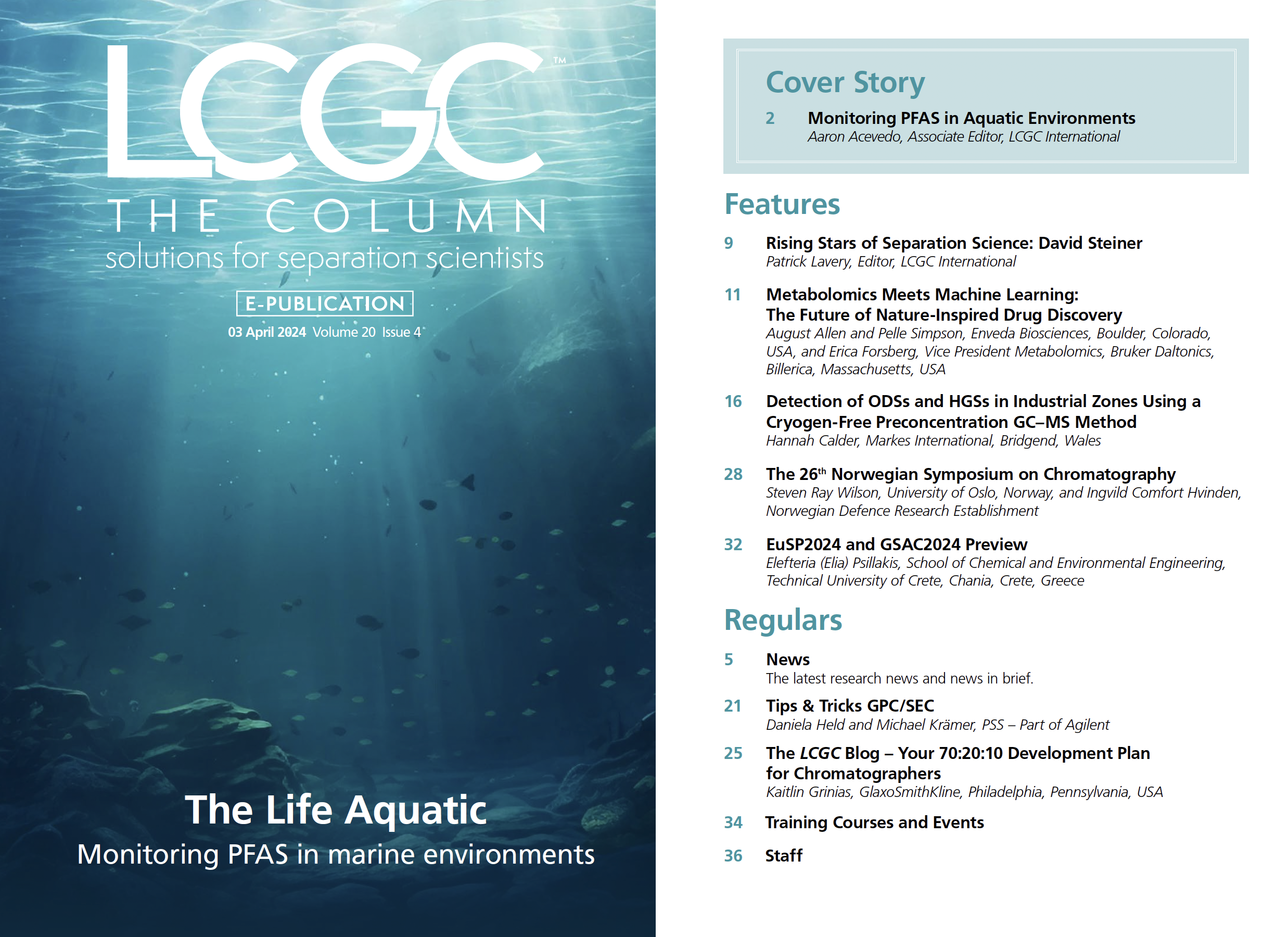Monitoring PFAS in Aquatic Environments
Yuefei Ruan from the City University of Hong Kong, China, discusses the relevance of target analysis, extractable organofluorine analysis, high-resolution mass spectrometry (HRMS) screening, and the oxidative conversion of precursors for the analysis of PFAS in aquatic environments.
Q: How do aquatic environments act as crucial compartments for per- and polyfluoroalkyl substances (PFAS)?
A: Unlike most persistent organic pollutants (POPs), one crucial characteristic of PFAS is their relatively high water solubility. This characteristic makes the aquatic environment a crucial compartment for the transportation and transformation of PFAS. In the case of surface water, PFAS can enter water bodies through direct discharges from industrial facilities, wastewater treatment plants, and runoff from contaminated areas. Once in the surface water, PFAS can disperse and accumulate within this compartment. For example, PFAS can bind to suspended particulate matter or dissolved organic matter in the surface water, leading to their long-range transport and potential deposition in sediment. PFAS can also infiltrate through the soil and reach the groundwater, contaminating this essential water resource. Groundwater is a long-term reservoir for PFAS, allowing PFAS to be persistent and potentially migrate to other water bodies. The contamination of groundwater with PFAS poses risks to drinking water supplies and aquatic ecosystems.
Q: What PFAS are common in aquatic matrices?
A: The two best-known PFAS, perfluorooctane sulfonic acid (PFOS) and perfluorooctanoic acid (PFOA, or C8), have been detected in aquatic matrices for more than 20 years. Although these substances have been phased out since 2009 and 2019, respectively, they are still widespread in water samples at present. With the restriction of C8 PFAS and deepened research on PFAS, the distribution of some shorter chain PFAS (for example, PFBA and PFBS) as well as some emerging PFAS (such as 6:2 Cl-PFESA and HFPO-DA) in the water bodies were increasingly reported in recent years.
Q: Why are target analysis, high-resolution mass spectrometry (HRMS) screening, oxidative conversion of precursors, and extractable organofluorine (EOF) analysis the most used methods for analyzing PFAS?
A: Over the past two decades, target analysis has been extensively used to investigate common PFAS when reference standards are available. Target analysis is a well-established method for PFAS analysis, delivering high sensitivity and accurate quantitative results.
However, the PFAS family encompasses a vast range of compounds with distinct properties, and there are currently over 5000 registered individual PFAS. Therefore, new methods shall be developed to discover and then detect a broader spectrum of PFAS.
The development of analytical standards for newly identified PFAS has fallen behind their production and release, leading to a shortage of reference standards for routine analysis. EOF analysis is generally used as a complementary approach for target analysis to determine the potential existence of unknown PFAS in water samples. The oxidative conversion method, a relatively fast approach with comparable low-method quantification like target analysis, is used to assess unknown PFAS precursors in water samples.
Oxidative conversion of PFAS precursors is a relatively novel method that aims to reveal PFAS precursor profiles beyond traditional target analysis. However, this oxidative conversion method falls short in identifying non-oxidizable emerging PFAS. To thoroughly examine the unknown PFAS, HRMS screening, including nontarget and suspect screening, has been increasingly utilized in recent years. The HRMS technique can provide accurate masses, isotopic distributions, and MS/MS spectra to discover emerging and unknown pollutants without reference standards. The application of PFAS HRMS screening can greatly expand our understanding of the structure and approximate concentration of unknown PFAS beyond the limited PFAS targets.
Q: Are there specific method combinations that prove most effective in analyzing PFAS in aquatic environments?
A: As the four approaches complement each other to reveal the PFAS contamination status, combining these methods is recommended to comprehensively reveal the PFAS pollution profiles in the aquatic environment. For example, embedding PFAS precursor oxidative conversion in HRMS screening can help evidence the presence of unknown PFAS.
Considering the time-consuming nature of the HRMS data processing, oxidative conversion can also help select samples of interest (that is, samples with high amounts of PFAS precursors with specific carbon chain lengths) for in-depth compound identification to improve the efficiency of HRMS screening. In addition, the oxidative conversion approach can reveal the structures and manufacturing processes of oxidizable PFAS precursors, and such knowledge can serve as supplementary information for identifying the structures of unknown PFAS via HRMS screening.
Conducting HRMS screening on the sample extract before and after the PFAS precursor oxidative conversion can provide detailed information on PFAS precursors, the result of which can distinguish whether certain unknown (or emerging) PFAS are oxidizable. Nontarget screening may reveal a possible new oxidation pathway and untended potential terminal oxidation products.
Q: Is there anything in your research that you found surprising?
A: Depending on the definition of PFAS chosen, the number of PFAS connections can vary from thousands to over 100,000. Consequently, the identification and evaluation of potential PFAS derived from precursors, as well as the precursors themselves, have become crucial approaches to developing problem statements concerning PFAS. However, the target analysis method, which could encompass up to dozens of PFAS, remains the most utilized method for investigating environmental behavior, conducting risk assessment, and implementing regulatory controls for PFAS in the aquatic environment. Our study suggests that appropriate tools shall be employed to effectively measure the significant unknown fraction of PFAS beyond the scope of target analysis. It supports the idea that regulatory actions should treat PFAS as a class rather than individual compounds.
Q: What’s something important about your work that you want readers of LCGC to know?
A: Many countries have actively pursued the eventual eradication of PFAS, and comprehending the current state-of-the-art analytical techniques is crucial for understanding the occurrence, transport, and fate of PFAS in the environment. PFAS can be readily transported in aquatic systems, and oceans are believed to be one of their final global sinks. PFAS in the marine environment can accumulate in marine organisms and bring potential adverse ecological effects.
Our research center, the State Key Laboratory of Marine Pollution (SKLMP), aims to protect the marine environment through high-quality multidisciplinary research and innovations relevant to pollution monitoring and control, environmental risk assessment, ecosystem responses to stressors, and ecological restoration. Therefore, we anticipate that our review paper will prove valuable to the environmental chemistry community and contribute to the protection of the aquatic environment, especially the marine environment.
This Q&A has been lightly edited for length and clarity.
References
(1) Per- and Polyfluorinated Substances (PFAS) Factsheet. Centers for Disease Control and Prevention. U.S. Department of Health & Human Services, 2022. https://www.cdc.gov/biomonitoring/PFAS_FactSheet.html (accessed 2023-12-12).
(2) Wang, Q.; Ruan, Y.; Yuen, C. N. T.; Lin, H.; Yeung, L. W. Y.; Leung, K. M. Y.; Lam, P. K. S. Tracing Per- and Polyfluoroalkyl Substances (PFASs) in the Aquatic Environment: Target Analysis and Beyond. TrAC, Trends Anal. Chem. 2023, 169, 117351. DOI: 10.1016/j.trac.2023.117351
Yuefei Ruan is a Professor at the City University of Hong Kong, Hong Kong, China, and the lead author of this study. Email: yruan8@cityu.edu.hk


New Method Explored for the Detection of CECs in Crops Irrigated with Contaminated Water
April 30th 2025This new study presents a validated QuEChERS–LC-MS/MS method for detecting eight persistent, mobile, and toxic substances in escarole, tomatoes, and tomato leaves irrigated with contaminated water.
University of Tasmania Researchers Explore Haloacetic Acid Determiniation in Water with capLC–MS
April 29th 2025Haloacetic acid detection has become important when analyzing drinking and swimming pool water. University of Tasmania researchers have begun applying capillary liquid chromatography as a means of detecting these substances.
Prioritizing Non-Target Screening in LC–HRMS Environmental Sample Analysis
April 28th 2025When analyzing samples using liquid chromatography–high-resolution mass spectrometry, there are various ways the processes can be improved. Researchers created new methods for prioritizing these strategies.

.png&w=3840&q=75)

.png&w=3840&q=75)



.png&w=3840&q=75)



.png&w=3840&q=75)

















